Tour of Missouri Sites Marks End of Mormon History Association Conference
Contributed By R. Scott Lloyd, Church News staff writer

Members of the Mormon History Association view a memorial commemorating the explosion of the steamboat Saluda, in which around 100 passengers, including over 20 Mormon immigrants, were killed in 1852.
Related Links
Capping the 52nd annual Mormon History Association Conference, held this year in St. Louis, Missouri, were two post-conference bus tours covering area Church historic sites.
One tour had as its destination historic Nauvoo, Illinois, by way of Hannibal, Missouri, and Quincy, Illinois (see related story).
The other tour—summarized in this report—was in western Missouri and included sites in Columbia, Lexington, Richmond, Liberty, Far West, Gallatin, Adam-ondi-Ahman, Far West, Hawn’s Mill, and Kingston.
Alexander L. Baugh, professor and chairman in the Department of Church History and Doctrine at Brigham Young University, led the tour. A recognized expert in the Missouri period of Church history, Baugh led participants through a busy 2½ days of touring, though the itinerary did not include the former Church headquarters city of Independence, instead focusing on some of the less-visited sites in Church history.
Stops on the tour are summarized below.
Boone County Courthouse in Columbia
This Missouri state capital is the location of the former Boone County Jail. There, Church leaders Parley P. Pratt, Morris Phelps, King Follett, and Luman Gibbs were unjustly incarcerated beginning May 26, 1839, stemming from a death in a conflict with mobs at the battle of Crooked River and, in the case of Follett, other incidents of violence.

A marker in a Richmond, Missouri, cemetery is at the gravesite of Austin King, the judge who adjudicated the hearing for Joseph Smith and other Mormon prisoners. King became governor of Missouri and later a U.S. congressman; hence it is the largest marker in the cemetery, which also includes the grave of David Whitmer. Photo by R. Scott Lloyd.

The grave marker of David Whitmer in a Richmond, Missouri, cemetery reflects the faithfulness of his witness to the Book of Mormon. Photo by R. Scott Lloyd.

One of the information panels on a monument at the Far West Temple site in Missouri, as viewed by members of the Mormon History Association during their post-conference tour June 5, 2017. Photo by R. Scott Lloyd.
Pratt and Phelps escaped July 4, but Follett was recaptured in the attempt. He was released September 25 and Gibbs November 4.
Both Phelps and Follett saw the escape in advance in vision, but Follett said he could not tell from the vision what would happen to him, Baugh recounted.
They picked July 4 as their day of liberation and even waved a makeshift flag from a window of the cell. Citizens of Columbia thought the gesture was in commemoration of Independence Day, not recognizing the double entendre.
The prisoners escaped by jumping the jailer as he brought in food.
The jail no longer exists, but the courthouse includes the site where it once stood.
The site marks the last chapter of Mormonism in the 1830s in Missouri, Baugh said.
Saluda memorial in Lexington
The tour visited a memorial park commemorating the April 9, 1852, explosion of the paddlewheel steamboat Saluda, which killed around 100 passengers, including 26 of a group of 75 Mormons immigrating to Utah. The memorial also honors the kindness of the citizens of Lexington in giving relief to the suffering survivors, including the Latter-day Saints.
The Mormon Historic Sites Foundation funded the construction of the memorial and, in partnership with the Lexington Historical Society, presented it to the city of Lexington on April 9, 2002.
David Whitmer homesite in Richmond
Tour participants then saw the homesite of David Whitmer, one of the Three Witnesses to the Book of Mormon. It was in Richmond where he lived out his life after his separation from the Church in June 1838 and where he died on January 25, 1888. A small plaque on the building marks the site, but the home was destroyed by a tornado in 1878. However, a surviving church next door existed while Whitmer was alive.
Whitmer was mayor of Richmond for a short time in the 1870s.
Many people came to visit him because he was the last surviving member of the Three Witnesses. He remained true to his testimony of the Book of Mormon throughout his life and testified of it frequently.
The printer’s manuscript of the Book of Mormon was handed down from Oliver Cowdery to his brother-in-law, David Whitmer, who gave it to his grandson, who sold it to the Reorganized Church of Jesus Christ of Latter Day Saints, now the Community of Christ, which has it to this day, Baugh said.
Ray County Courthouse in Richmond
In Far West, Joseph Smith and 64 other Mormon men were arrested and brought to Richmond for a hearing stemming from the Mormon War in Missouri. The tour came to the site in Richmond, although the courthouse that stands today is not the building where their preliminary hearing was held on November 13, 1838.
In front of the current courthouse is a heroic-sized statue of Alexander W. Doniphan, who lived in Richmond for 19 years. His was a household name in western Missouri. He was honored as a national hero in the war with Mexico, in which he commanded the Missouri Volunteers. He later founded William Jewell College near Liberty, Missouri.
However, Latter-day Saints have their own reasons for honoring him.
Doniphan, a militia general, refused to obey an illegal order to execute Joseph Smith and other Mormon leaders. Later, as an attorney, he defended the Mormon prisoners in Richmond.
The hearing lasted 17 days, after which Joseph Smith, Sidney Rigdon, Hyrum Smith, Alexander MacRae, Caleb Baldwin, and Lyman Wight were bound over for trial by Judge Austin King on charges of treason. They were then sent to the jail in Liberty.
Site of the vacant log house in Richmond where Joseph Smith rebuked the guards
A marker identifies the lot where the vacant log house stood where Joseph and six others were confined in chains beginning November 9, 1838, for the pending preliminary hearing. It was there that, according to Parley P. Pratt’s autobiography, Joseph rebuked guards who were making vile boasts about atrocities committed against the Mormons.
The marker was erected by the Missouri Mormon Frontier Foundation on November 19, 2011. John and Kip Craig of Calgary, Canada, purchased and donated the property.
Three Witnesses monument in Pioneer Cemetery, Richmond
In the Pioneer Cemetery in Richmond are buried Peter Whitmer Sr., Mary Musselman Whitmer, Jacob Whitmer, Oliver Cowdery, and Whitmer family descendants.
An 1878 tornado wiped out the cemetery. In 1911, Junius F. Wells was assigned by the Church to identify the gravesite of Oliver Cowdery. There, a monument was erected to honor the Three Witnesses to the Book of Mormon. As part of that event, the Church beautified the cemetery and has maintained it to this day.
The Mormon Tabernacle Choir, en route home from an Eastern states tour, performed in Richmond for the dedication of the monument by Heber J. Grant, then senior member of the Quorum of the Twelve.
The monument was rededicated 100 years later on November 19, 2011.
Oliver Cowdery, the brother-in-law of David Whitmer, died in Richmond on March 3, 1850, after rejoining the Church in 1848 at Winter Quarters, Nebraska. He had planned to go west with the Saints but died in Richmond while staying with his Whitmer relatives.
David Whitmer gravesite in Richmond
David Whitmer, one of the Three Witnesses to the Book of Mormon, is buried in Richmond City Cemetery. The tour group visited the gravesite and also saw the monument on the grave of Austin King, the judge who bound Joseph Smith and the other prisoners over for trial. King’s monument is the largest and most imposing in the cemetery because he later became governor of Missouri, and the state has built monuments for its former governors, Baugh said.
On Whitmer’s grave is the inscription “The record of the Jews and the record of the Nephites are one,” signifying his abiding witness of the Book of Mormon.
Eight Witnesses monument in Liberty
Driven from Jackson County, Missouri, the Latter-day Saints went to Clay County; many ended up in Liberty in 1834. There, they were aided by property owner Michael Arthur, who employed 10 to 12 families. Baugh said the Arthur property became the Missouri headquarters of the Church during that period.
After the failure of Zion’s Camp to redeem the lands in Jackson County, Joseph Smith came to meet with the Missouri Saints in Liberty, and Zion’s Camp was disbanded on the Arthur property.
There, Joseph organized the Missouri presidency of the Church with David Whitmer as president and a high council on July 3, 1834.
In 1835 and 1836, Christian Whitmer and Peter Whitmer Jr. died and were likely buried in the cemetery on the Arthur land.
In 2011, the cemetery property was acquired for the Church by the Craig brothers of Calgary, and on the same day of the centennial rededication of the Three Witnesses monument in Richmond, a monument of similar design to honor the Eight Witnesses to the Book of Mormon was dedicated on the Arthur land in Liberty.
Panels on the monument memorialize the events that took place there: Zion’s Camp disbanding, Michael Arthur’s kindness, the organization of the high council, and the burial of two of the Eight Witnesses in the cemetery. One of the panels contains the names of all of the Eight Witnesses.
Gravesite of Alexander W. Doniphan in Liberty
Though he lived in Richmond, Ray County, for 19 years, Clay County also claims Alexander W. Doniphan. His grave is in a cemetery in Liberty, because that is where his wife, Elizabeth Jane, was buried, as were his two sons, who each suffered an accidental death in young adulthood.
A tall obelisk marks his grave. There, tour group members viewed his epitaph: “An orator, jurist, statesman, soldier, and a Christian.”
Far West Temple site
After Alexander Doniphan was elected to the Missouri legislature in 1836, he proposed a county be established for the Mormons, who had been driven from Jackson to Clay County. It was named Caldwell County. A town to be named Far West was designated as the county seat.
Beginning in August, Church members began settling the site.
By July 3, 1837, residents started an excavation for a temple. In a single day, 500 men and boys had excavated a site 110 feet by 80 feet by 5 feet deep.
That site was visited by members of the Mormon History Association tour group.
Seven canonized revelations were received in Far West: Doctrine and Covenants 113–115 and 117–120.
On July 4, 1837, the cornerstones of the temple were laid. Those cornerstones, now with protective covers, can be viewed today. Wilford Woodruff and George A. Smith were ordained Apostles on the southeast cornerstone.
By February 1839, Latter-day Saints were expelled from Missouri by the governor and thus left Far West behind.
The Church made improvements to the Far West site in 1968, including information panels highlighting revelations received at Far West, such as the commandment to build the temple, the name of the Church, the law of tithing, and the calls to the Quorum of the Twelve to serve missions in England. Jonna Forbes, a member of the tour group, remembered attending the site’s dedication as a child.
Adam-ondi-Ahman
Adam-ondi-Ahman was a settlement by the Saints in Daviess County, Missouri, in May 1838. The location was identified in a revelation, Doctrine and Covenants 116, as the place where Adam will come to visit his people. The revelation also indicated that it was the place where Adam and Eve dwelt after they left the Garden of Eden and where Adam blessed his posterity.
Members of the tour group viewed Tower Hill and a location overlooking Spring Hill, the site of a future meeting where Christ will meet with Adam and the righteous Saints of all gospel dispensations.
Hawn’s Mill
Bitterness stemming from conflicts between Mormons and older settlers in Daviess County precipitated a horrific attack by a mob on the tiny settlement of Hawn’s Mill on October 30, 1838, in which 17 men and boys were killed and 15 others were wounded.
The dead were placed in a dry well that served as a common grave.
A subsequent property owner, Charles Ross, put more dirt in the well and placed a red stone, an unshaped millstone, on the top of the well to mark it.
The tour group visited the site where the mill was located along Shoal Creek.
They viewed a marker placed on the property by a later property owner. Unfortunately, the property owner moved the millstone marking the well and placed it near the marker, “thus forever losing the identification of the well,” Baugh said.
John Whitmer’s gravesite in Kingston
The tour group visited the gravesite of John Whitmer, one of the Eight Witnesses to the Book of Mormon, in a cemetery in Kingston. In an 1831 revelation now recorded as Doctrine and Covenants 47, he was directed to compile a history of the Church, making him the first Church historian.
“As scant as it is, there’s material in there that we otherwise would not have,” Baugh said. “He recorded some very important information.
“So I honor those witnesses. They were all true to their testimony of the Book of Mormon, and they were as true as they could feel to the Restoration.”
Whitmer helped found Far West and, after the expulsion of the Saints, went back there to claim part of the property for himself. “So in a way, he preserved the temple property and passed that on to his heirs,” Baugh said.
In 1999, Baugh helped Ron Romig, archivist for the Community of Christ, place the grave marker.
Liberty Jail Historic Site in Liberty
The tour group visited the Church’s Liberty Jail Historic Site and visitors’ center in Liberty. Within the rotunda of an exterior building is a cut-away replica of the original jail in which Joseph Smith and his fellow prisoners were confined after being bound over for trial in Richmond.
The group listened to the narration given in the visitors’ center about the prisoners’ five-month confinement in the winter of 1838–39, during which Joseph received the revelations now recorded as Sections 121–123 of the Doctrine and Covenants.
Though conditions in Liberty Jail were squalid, Baugh said some of the information that has been passed down through the years is inaccurate. The dungeon was 6½ feet high, enough for the prisoners to stand upright, he said. They were not fed human flesh (their attorney, Alexander Doniphan, would not have abided that), and they were allowed out from time to time to get a meal or visit their attorney’s office, Baugh said.
He gave evidence suggesting that Hyrum Smith, confined with his brother, might have blessed his infant son, Joseph F. Smith, during a visit to the jail by Hyrum’s wife, Mary Fielding Smith, who brought Joseph F. with her.

Alexander L. Baugh speaks to members of the Mormon History Association in Lexington, Missouri, at the memorial commemorating the explosion of the steamboat Saluda in which around 100 passengers, including over 20 Mormon immigrants, were killed in 1852. Photo by R. Scott Lloyd.

The Missouri River as viewed from bus by members of the Mormon History Association on a post-conference tour June 4, 2017. Photo by R. Scott Lloyd.

This statue of Alexander W. Doniphan is in front of the Ray County Courthouse in Richmond, Missouri, where he is remembered as a hero of the war with Mexico. Doniphan is remembered by Mormons for his heroic refusal to obey an illegal order to execute Joseph Smith and other Mormon leaders. Photo by R. Scott Lloyd.

During a Mormon History Association post-conference tour, Alexander L. Baugh, left, tells about a monument to the Three Witnesses to the Book of Mormon situated in a cemetery in Richmond, Missouri, at gravesite of Oliver Cowdery. Photo by R. Scott Lloyd.

Members of the Mormon History Association view the grave of David Whitmer in a Richmond, Missouri, cemetery during a post-conference tour June 4, 2017. Photo by R. Scott Lloyd.
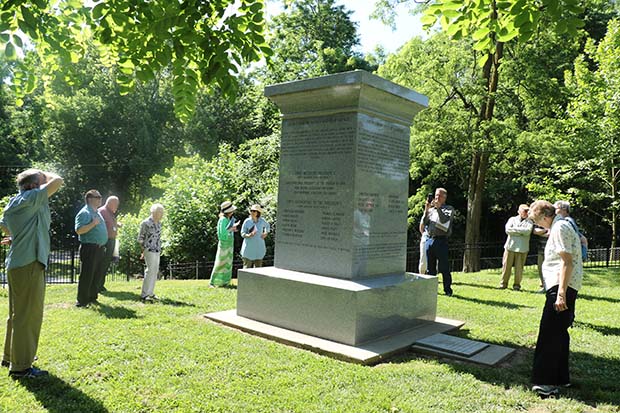
Members of the Mormon History Association view the monument to the Eight Witnesses to the Book of Mormon in Liberty, Missouri, during a post-conference tour on June 4, 2017. Photo by R. Scott Lloyd.
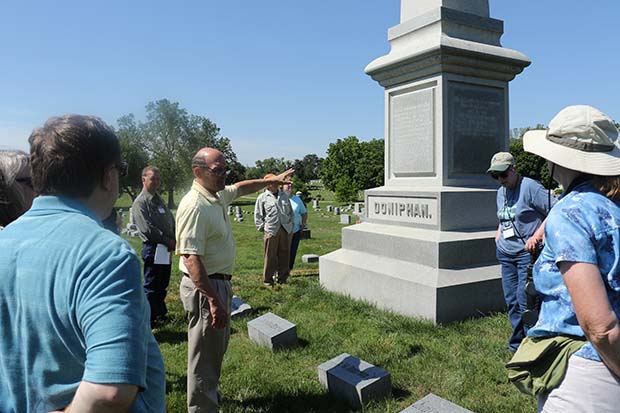
Alexander L. Baugh speaks to members of the Mormon History Association at the gravesite of Alexander W. Doniphan in Liberty, Missouri, during a post-conference tour. Photo by R. Scott Lloyd.

At the Far West Temple site in Missouri, Alexander L. Baugh speaks to members of the Mormon History Association during a post-conference tour on June 5, 2017. Photo by R. Scott Lloyd.

One of four cornerstones laid at the Far West Temple site in Missouri as viewed by members of the Mormon History Association during a post-conference tour on June 5, 2017. Photo by R. Scott Lloyd.

Members of the Mormon History Association gather around one of the four cornerstones at the Far West Temple site in Missouri during a post-conference tour. Photo by R. Scott Lloyd.

The Far West Temple site in Missouri as viewed through an iron fence. Seen by members of the Mormon History Association during their post-conference tour on June 5, 2017. Photo by R. Scott Lloyd.
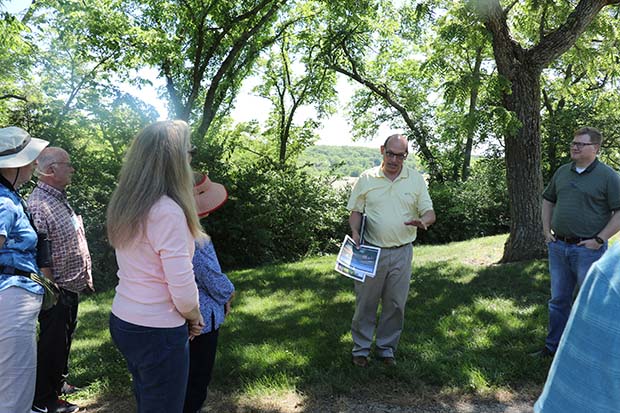
Alexander L. Baugh speaks to members of the Mormon History Association at Tower Hill in Adam-ondi-Ahman during a post-conference tour on June 5, 2017. Photo by R. Scott Lloyd.

A plaque marks the dedication by President Alvin R. Dyer of improvements to Adam-ondi-Ahman in Missouri. Photo by R. Scott Lloyd.

Alexander L. Baugh points out topographic features of Adam-ondi-Ahman on an aerial photograph during a visit to the site by members of the Mormon History Association during their post-conference tour June 5, 2017. Photo by R. Scott Lloyd.

A marker placed in 1941 identifies the Hawn’s Mill massacre site in Missouri. A partially formed millstone near the marker had covered the dry well into which the bodies of massacre victims were interred, but the stone was moved by a past property owner. Photo by R. Scott Lloyd.

On the bank of Shoal Creek in Missouri, Alexander L. Baugh tells members of the Mormon History Association about the Hawn’s Mill massacre that occurred on that site in 1838. Photo by R. Scott Lloyd.

Detail of the grave marker of John Whitmer in Kingston, Missouri, as viewed by members of the Mormon History Association during a post-conference tour June 5, 2017. Photo by R. Scott Lloyd.

Members of the Mormon History Association visit the grave of John Whitmer in Kingston, Missouri, on June 5, 2017. Photo by R. Scott Lloyd.

The exterior of the Liberty Jail Visitors’ Center in Liberty, Missouri, visited by members of the Mormon History Association during a post-conference tour on June 6, 2017. Photo by R. Scott Lloyd.
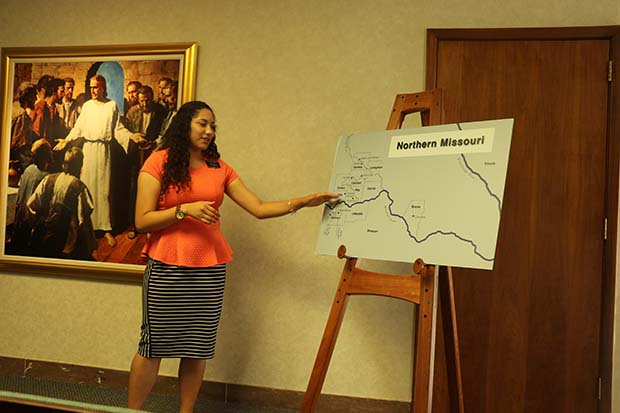
Inside the Liberty Jail Visitors’ Center, members of the Mormon History Association listen to Sister Jackie Garay tell about the confinement of Joseph Smith and other Church leaders in the jail during the winter of 1838–39. Photo by R. Scott Lloyd.

Inside the rotunda of the Liberty Jail Visitors’ Center, Sister Jackie Garay tells members of the Mormon History Association about the confinement of Joseph Smith and other Church leaders in the jail during the winter of 1838–39. Photo by R. Scott Lloyd.
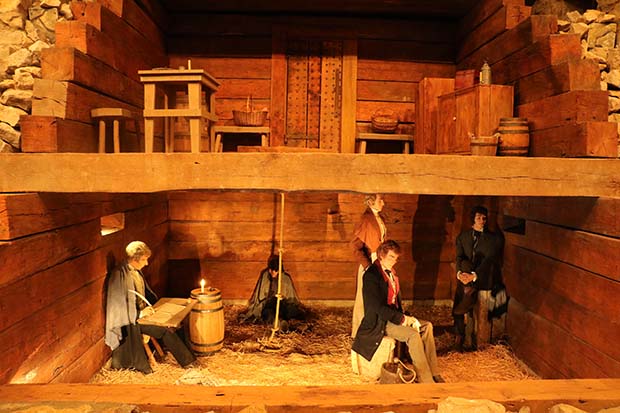
Cutaway diorama of Liberty Jail inside the visitors’ center as viewed by members of the Mormon History Association during their post-conference tour on June 6, 2017. Photo by R. Scott Lloyd.
